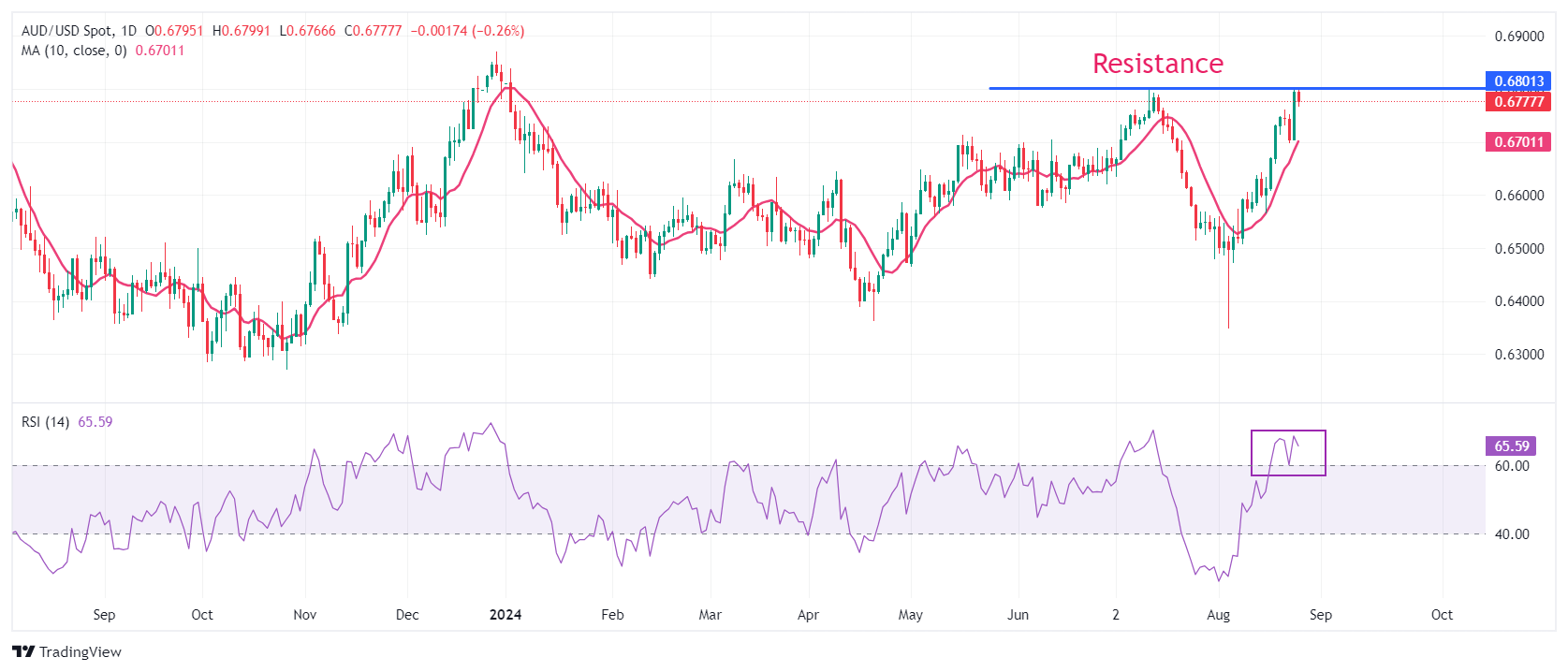AUD/USD Price Forecast: Corrects mildly from 0.6800
|
- AUD/USD drops from 0.6800 with Aussie inflation under the spotlight.
- The Fed seems prepared to begin reducing interest rates from September.
- The near-term outlook of the US Dollar remains weak.
The AUD/USD pair falls from the monthly high of 0.6800 in Monday’s American session. The Aussie asset drops as the US Dollar (USD) edges higher. While the near-term outlook of the US Dollar remains vulnerable as the Federal Reserve (Fed) is widely anticipated to start reducing interest rates from the September meeting.
The US Dollar Index (DXY), which tracks the Greenback’s value against six major currencies, rises slightly to near 100.90 from the annual low of 100.53.
While the Fed seems certain to cut interest rates in September, traders remain split over the likely size. According to the CME FedWatch tool, 30-day Federal Funds futures pricing data shows that the likelihood of a 50-basis point (bps) interest-rate reduction is 36.5%, while rest of the bets are in favor of a 25-bps rate cut.
Meanwhile, the Australian Dollar (AUD) will be influenced by the monthly Consumer Price Index (CPI) data for July, which will be published on Wednesday. Economists estimated that price pressures declined sharply to 3.4% from 3.8% in June. An expected decline in the inflation data would bring expectations of interest rate cuts to the table.
AUD/USD trades close to the monthly high of 0.6800 on a daily timeframe. The near-term outlook of the Aussie asset remains firm as the 10-day Moving Average (EMA) near 0.6700 is sloping higher. The 14-period Relative Strength Index (RSI) oscillates in the bullish range of 60.00-80.00, suggesting a strong upside momentum.
For a fresh upside, a decisive move above the round-level resistance of 0.6800 will push the asset higher to 0.6840, the higher level seen this year. A breach of the latter would drive the asset towards December 2023 high of 0.6870.
In an alternate scenario, a downside move below August 19 low of 0.6660 will expose the asset to June 28 low of 0.6620 and June 17 low of 0.6585.
AUD/USD daily chart
Australian Dollar FAQs
One of the most significant factors for the Australian Dollar (AUD) is the level of interest rates set by the Reserve Bank of Australia (RBA). Because Australia is a resource-rich country another key driver is the price of its biggest export, Iron Ore. The health of the Chinese economy, its largest trading partner, is a factor, as well as inflation in Australia, its growth rate and Trade Balance. Market sentiment – whether investors are taking on more risky assets (risk-on) or seeking safe-havens (risk-off) – is also a factor, with risk-on positive for AUD.
The Reserve Bank of Australia (RBA) influences the Australian Dollar (AUD) by setting the level of interest rates that Australian banks can lend to each other. This influences the level of interest rates in the economy as a whole. The main goal of the RBA is to maintain a stable inflation rate of 2-3% by adjusting interest rates up or down. Relatively high interest rates compared to other major central banks support the AUD, and the opposite for relatively low. The RBA can also use quantitative easing and tightening to influence credit conditions, with the former AUD-negative and the latter AUD-positive.
China is Australia’s largest trading partner so the health of the Chinese economy is a major influence on the value of the Australian Dollar (AUD). When the Chinese economy is doing well it purchases more raw materials, goods and services from Australia, lifting demand for the AUD, and pushing up its value. The opposite is the case when the Chinese economy is not growing as fast as expected. Positive or negative surprises in Chinese growth data, therefore, often have a direct impact on the Australian Dollar and its pairs.
Iron Ore is Australia’s largest export, accounting for $118 billion a year according to data from 2021, with China as its primary destination. The price of Iron Ore, therefore, can be a driver of the Australian Dollar. Generally, if the price of Iron Ore rises, AUD also goes up, as aggregate demand for the currency increases. The opposite is the case if the price of Iron Ore falls. Higher Iron Ore prices also tend to result in a greater likelihood of a positive Trade Balance for Australia, which is also positive of the AUD.
The Trade Balance, which is the difference between what a country earns from its exports versus what it pays for its imports, is another factor that can influence the value of the Australian Dollar. If Australia produces highly sought after exports, then its currency will gain in value purely from the surplus demand created from foreign buyers seeking to purchase its exports versus what it spends to purchase imports. Therefore, a positive net Trade Balance strengthens the AUD, with the opposite effect if the Trade Balance is negative.
Information on these pages contains forward-looking statements that involve risks and uncertainties. Markets and instruments profiled on this page are for informational purposes only and should not in any way come across as a recommendation to buy or sell in these assets. You should do your own thorough research before making any investment decisions. FXStreet does not in any way guarantee that this information is free from mistakes, errors, or material misstatements. It also does not guarantee that this information is of a timely nature. Investing in Open Markets involves a great deal of risk, including the loss of all or a portion of your investment, as well as emotional distress. All risks, losses and costs associated with investing, including total loss of principal, are your responsibility. The views and opinions expressed in this article are those of the authors and do not necessarily reflect the official policy or position of FXStreet nor its advertisers.
